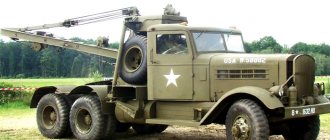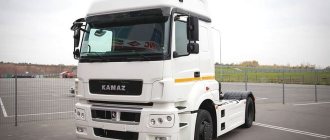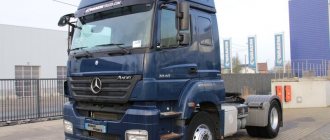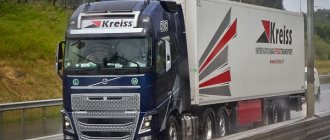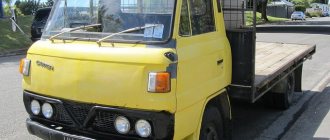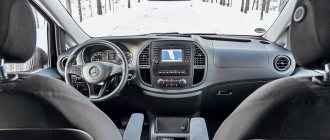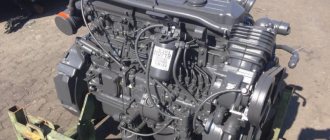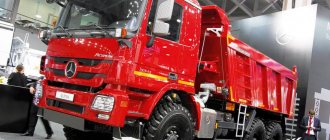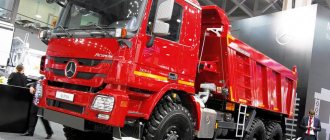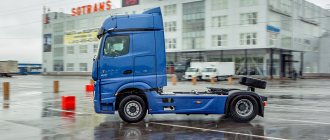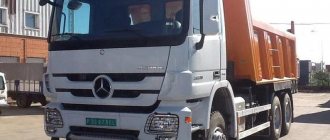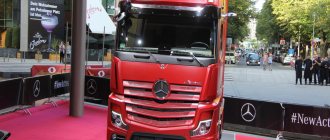Wikipedia list article
| This article need additional quotes for verification . |
Below is a list of trucks produced by Mercedes Benz.
Content
- 1 1926–1944 1.1 L1, L2 and L5 (1926–1932)
- 1.2 L3/4 and L1000 Express (1927-1936)
- 1.3 Light trucks (1932-1941)
- 1.4 Semi-trailer tractors (1932–1938)
- 1.5 L5000 (1932–1936)
- 1.6 Heavy trucks (1934–1939)
- 1.7 LG and LR (1934–1944)
- 1.8 L1100, L1500 and L2000 (1936–1941)
- 1.9 L1500, L3000 and L4500 (1939–1944)
- 2.1 L4500 (1945-1961)
- 3.1 Kurzhauber (1959–1988)
- 4.1 New generation (1974–1988)
The magical power of art
The most unexpected turn in the history of snub-nosed Mercs was their contribution... to the development of KAMAZ vehicles and to domestic cinema.
Many people remember the film “The World Guy” in the title role with Nikolai Olyalin. It was filmed in 1970 and released in 1971. According to the plot, during testing of various trucks in the Middle East, the “bourgeois” are opposed by the Soviet MAZ-516. The snub-nosed Mercedes-Benz LS 322 became the only (SIC!) truck tractor in the film, and the logic of a savvy driver dictates that it is clearly superfluous here in the plot! The Mercedes truck tractor was clearly not suitable for competition with ordinary trucks that go without couplings.
Behind the scenes of the latest film were newer Mercedes-Benz trucks that were submitted for testing at NAMI, but it would be strange to advertise them.
Foreign trucks reached car factories in three ways. Trade missions, foreign service corps and airlines often got rid of 5-7 year old cars on the spot. But these were already shabby copies.
After exhibitions, foreign manufacturers often left some exhibits as a gift, so as not to have to take them home with a pile of papers and declarations through customs, borders, parking lots, hotels, and traffic police pickets.
This squandering of capitalist property also had a pragmatic side, which sometimes ended in a good contract. For example, the events shown in the melodrama “Vacation at your own expense” (Hungary–USSR, 1982) had several real prototypes in the 1960–1970s. In the plot of the film, a representative of a French company gives an expensive experimental exhibit (a certain “Python”) to teacher Katya Kotova from Verkhneyarsk at an exhibition in Budapest. Having previously seen her in the deputy minister’s office, he decided that she was his relative, promptly gave her a bag with an exhibit, and the film plot unwinds into a new phase.
Things were even simpler with cars that cost a lot of money. They were bought! Throughout the 1960s through the 1980s, industry institutes were widely funded to study advanced foreign-made designs and were not challenged. This is how, in the fall of 1970, three snub-nosed Mercs fell into the hands of NAMI specialists at once: an all-wheel drive Mercedes-Benz LAK 2624 6x6 (typ 343) mining dump truck with a Meiller-Kipper body, an onboard Mercedes-Benz L 1817 6x4 (typ 360) and a three-axle Mercedes -Benz LP 1113 (typ 358) with 3-sided unloading.
1945–1960
The post-war era saw the recovery of the freight industry. However, in the mid-fifties, Germany's first Federal Minister of Transport, Hans-Christoph Seebohm, passed a series of laws promoting the Bundesbahn at the expense of the road transport industry. Strict weight and size restrictions were especially detrimental to export-dependent Mercedes-Benz, as they had to develop duplicate truck lines, one for export and one for the limited German market.[1] These restrictions were lifted from 1960, allowing Mercedes-Benz to once again focus its efforts on creating a single model range.
L4500 (1945-1961)
See also: Mercedes-Benz L 4500
| Years | Interior designations (BM) | Sales designation | Engine | N cylinder volume | Horsepower | Full mass | Payload |
| 1945–1948 | 303 | L 4500 | OM 67/4 | 6-7270 | 112 hp | 10.5 t | 4.5 t |
| 1948–1952 | 303 | L 5000 | OM 67/4 | 6-7270 | 112 hp | 10.5 t | 5.0 t |
| 1952–1953 | 303 | L 5500 | OM 67/8 | 6-7270 | 120 hp | 11 t | 5.5 t |
| 1953–1957 | 325 | L 5500 / L 325 | OM 325 | 6-7270 | 125 hp | 11.3-12 t | 5.9-6.6 t |
| 1957–1961 | 330 | L 330 (export) | OM 315 | 6-8280 | 125 hp | 12-13 t | 6.6-7.6 t |
L3500/L4500 (1949–1961)
| Years | Interior designations (BM) | Sales designation | Engine | N cylinder volume | Horsepower | Full mass | Payload |
| 1949–1950 | 311 | L 3250 | OM 312 | 6-4580 | 90 hp | 6.5 t | 3.25 t |
| 1950–1961 | 311 | L/LP 3500/L/LP 311 | OM 312 | 6-4580 | 90-100 hp | 6.7 t | 3.5 t |
| 1953–1961 | 312 | L/LP 4500/L/LP 312 | OM 312 | 6-4580 | 90-100 hp | 8.5 t | 4.5 t |
| 1957–1959 | 321 | L/LP 321 | OM 321 | 6-5100 | 110 hp | 9.3 t | 5.2-5.4 t |
L6600 (1950–1962)
| Years | Interior designations (BM) | Sales designation | Engine | N cylinder volume | Horsepower | Full mass | Payload |
| 1950–1958 | 304 | L 6600 / L / LP 315 | OM 315 | 6-8280 | 145 hp | 12.6 t | 6.6 t |
| 1957–1958 | 326 | L/LP 326 | OM 326 | 6-10810 | 192-200 hp | 16 t | 8.6 t |
| 1956–1957 1957–1962 | 329 | L/LP 329 | OM 315 OM 326 | 6-8280 6-10810 | 145 hp 172 hp | 12 t | 6.5 t |
| 1957–1959 | 331 | L/LP 331 (export) | OM 326 | 6-10810 | 150-172 hp | 15 t | 8 t |
| 1958–1962 | 332 | L/LP 332 (export) | OM 326 | 6-10810 | 172 hp | 17.5 t | 11 t |
| 334 | L/LP 334 (export) | OM 326 | 6-10810 | 192-200 hp | 19 t | 12 t |
Nomenclature: In 1954, the old four-digit model series designation (indicating payload in kilograms) was replaced by a three-digit model series designation, which largely followed the internal designations of Mercedes-Benz models (internal design codes). This nomenclature was used for almost 10 years, from 1954 to 1963.
Cab-over-engine versions of most trucks have also been available since 1954. For example, LP4500 (1954) and LP315 (1955). However, there was only one model that existed only as a cab-over-engine version, the "Centipede" (LP 333).
| Years | Interior designations (BM) | Sales designation | Engine | N cylinder volume | Horsepower | Full mass | Payload |
| 1958–1961 | 333 | LP 333 | OM 326 | 6-10810 | 200 hp | 16 t 20 t 22.5 t | 9.2 t 12.5 t 14.7 t |
Cabin Mercedes-Benz 814
The cabin of the Mercedes-Benz 814 can comfortably accommodate three people, but in some modifications there are only two seats: a driver and one passenger. Also, in some cab options there is a berth behind the seats. The inside of the cabin is quite spacious and comfortable, and the precise and carefully thought-out arrangement of all truck controls allows the driver to feel comfortable. The ceiling is usually low or high. The floor in the cabin is flat.
Electronic systems are practically not used in controlling this machine, so its operation is extremely simple. The steering mechanism has a two-spoke, fairly large steering wheel, and a hydraulic booster. Ergonomic, strict and laconic old-fashioned dashboard; The sprung seat is simple but quite comfortable.
The level of vibration and noise insulation of the cabin is quite good. But in many regions of Russia it is simply impossible to do without additional heating in winter. Because the cockpit glass area is very large.
1970–1980s
- Mercedes-Benz NG ( New generation
)
New generation (1974–1988)
1st generation (NG74):
| Years | Interior designations (BM) | Sales designation | Engine | Horsepower | Full mass |
| 1974–1984 | 380 | 1013, 1017, 1019 | OM 352, OM 401 | 130-190 hp | 10 t |
| 381 | 1213, 1217, 1219 | OM 352, OM 401 | 130-190 hp | 12 t | |
| 383 | 1413, 1417, 1419, 1424 | OM 352, OM 401, OM 402 | 130-240 hp | 14 t | |
| 385 | 1613, 1617, 1619, 1624 2219, 2224 | OM 352, OM 401, OM 402 | 130-240 hp | 16 t 22 t | |
| 387 | 1626, 1632 1719, 1732 | OM 401, OM 402 | 260-320 hp | 16 t 17 t | |
| 389 | 1919, 1926, 1932 | OM 401, OM 402 | 190-320 hp | 19 t | |
| 391 | 2026 U., 2032 U. | OM 402, OM 403 | 260-320 hp | 20 t | |
| 393 | 2226, 2232 | OM 402, OM 403 | 260-320 hp | 22 t | |
| 395 | 2626, 2632 | OM 402, OM 403 | 260-320 hp | 26 t |
2nd and 3rd generations (NG80, 1980–1985 and NG85, 1985–1988):
| Years | Interior designations (BM) | Sales designation | Engine | Horsepower | Full mass |
| 1980–1988 | 615 | 1214, 1217, 1220, 1222, 1225 | OM 362, OM 366 OM 421, OM 442 | 140-250 hp | 12 t |
| 616 | 1414, 1417, 1419, 1420, 1422, 1425 | OM 362, OM 366 OM 421, OM 442 | 140-250 hp | 14 t | |
| 617 | 1614, 1617, 1619, 1620, 1622, 1625 | OM 362, OM 366 OM 421, OM 442 | 140-250 hp | 16 t | |
| 619 | 2219, 2220, 2222, 2225 | OM 362, OM 366 OM 421, OM 442 | 190-250 hp | 22 t | |
| 620 | 1628, 1633, 1635, 1636, 1638, 1644 | OM 421, OM 422, OM 423, OM 441, OM 442, OM 443 | 280-440 hp | 16 t | |
| 621 | 1922, 1928, 1933, 1936, 1938 | OM 421, OM 422, OM 423, OM 441, OM 442, OM 443 | 220-380 hp | 19 t | |
| 622 | 2028LS, 2033LS, 2036LS | OM 422 | 280-360 hp | 20 t | |
| 623 | 2228, 2233, 2236, 2238 2628, 2636, 2638 3028, 3033, 3036, 3038 3333 | OM 422 | 280-330 hp | 22 t 26 t 30 t 33 t | |
| 624 | 2628, 2633, 2636, 2638 3328, 3333, 3336 | OM 422 | 280-360 hp | 26 t 33 t | |
| 625 | 3850 | 500 hp | 38 t |
Snub-nosed alligator
The hood of the new trucks now opened from the bumper, like the mouth of a crocodile, and for this originality, drivers, at the suggestion of specialized media, called the unusual short-hooded trucks “alligators.” The cars were equipped with 6-cylinder 10.81-liter OM 346 diesel engines with a power range from 192 to 218 hp; later, for the heavy range, more powerful 6-cylinder 11.58-liter OM 355 units with power from 210 to 240 were created strength There were also light (8720 cm3) in-line engines OM 360 with a power of 192 hp.
The design of snub-nosed trucks provided improved visibility and handling while maintaining the same load capacity and volume of usable space as the “classics”. However, the noise and heat flow from the engine was still not a pleasant experience for drivers.
The new series was developed over the course of three years in several versions: flatbed trucks, dump trucks and truck tractors with two or three axles. Later a chassis with all-wheel drive was added. Special versions of the chassis were created for the installation of firefighting and utility superstructures. Snub-nosed Mercedes-Benz quickly gained success in export markets. This series of trucks has become an important pillar of Daimler AG around the world. Between 1964 and 1979, the largest order was completed for the production of 226,930 Mercedes-Benz L 1210 vehicle kits, which were then supplied to India.
2000s
Mercedes-Benz Arocs 6x6
- Mercedes-Benz Atego - light truck from 7 to 16 tons
- The Mercedes-Benz Axor is a medium-duty truck with a rigid and articulated capacity from 18 to 26 tons.
- Mercedes-Benz Actros - reinforced rigid and premium articulated - from 18 to 250 tons
- Mercedes-Benz Atron
- Mercedes-Benz Econic - Axor version with low floor for waste and special work
- Mercedes-Benz Unimog - for special applications and transport over extreme terrain
- Mercedes-Benz Zetros - an SUV for extreme work
- 1828L (F581) Mobile casualty treatment center
- 1517L Mobile casualty treatment center
- Mercedes-Benz Arocs
- Mercedes-Benz Antos
2013[3]
| Years | Interior designations (BM) | Internal series code | Sales designation | Engine |
| 900 | 310 CDI, 510 CDI | M651 D22 | ||
| 1995–2006 | 901 | T1N | Sprinter 2… | M 111, OM 601, OM 602, OM 611 |
| 902 | T1N | Sprinter 2… | M 111, OM 601, OM 602, OM 611, OM 612 | |
| 903 | T1N | Sprinter 3… | M 111, OM 601, OM 602, OM 611, OM 612 | |
| 904 | T1N | Sprinter 4… | M 111, OM 601, OM 602, OM 611, OM 612 | |
| 905 | T1N | Sprinter 6... | OM 612 | |
| 2007–present | 906 | NCV3 | Sprinter II | M 271, M 272, OM 642, OM 646, OM 651 |
| 2013–present | 909 | T1N | Sprinter (Russia) | OM 646 |
| 2002–2011 | 930 | SKN | Actros "MP2, MP3", hard | OM 501, OM 502 |
| 932 | SKN | Actros "MP2, MP3", tipper (K) | OM 501, OM 502 | |
| 933 | SKN | Actros "MP2, MP3", concrete mixer (B) | OM 501, OM 502 | |
| 934 | SKN | Actros "MP2, MP3", tractor (S, LS) | OM 501, OM 502 | |
| 2001–2013 | 940 | SKN-C SKN-R | Axor, hard | OM 457 |
| 942 | SKN-C SKN-R | Axor, tipper (K) | OM 457 | |
| 943 | SKN-C SKN-R | Axor, concrete mixer (B) | OM 457 | |
| 944 | SKN-C SKN-R | Axor, tractor (S, LS) | OM 457 | |
| 2009–present | 949 | Zetros | OM 926 | |
| 1996–2002 | 950 | SKN SKN-R SKN-C | Actros, hard Atego, hard Axor, hard | OM 501, OM 502, OM 906, OM 926 |
| 952 | SKN SKN-R SKN-C | Actros, tipper (K) Atego, dump truck (K) Axor, tipper (K) | OM 501, OM 502, OM 906, OM 926 | |
| 953 | SKN SKN-R SKN-C | Actros, concrete mixer (B) Atego, concrete mixer (B) Axor, concrete mixer (B) | OM 501, OM 502, OM 906, OM 926 | |
| 954 | SKN SKN-R SKN-C | Actros, tractor (S, LS) Atego, tractor (S, LS) Axor, tractor (S, LS) | OM 501, OM 502, OM 906, OM 926 | |
| 2013–present | 956 | Econic (II) | OM 936 | |
| 1998–2013 | 957 | Econic | OM 906, OM 926 | |
| 958 | Atego, Axor (Brazil) | OM 457, OM 904, OM 924 | ||
| 2011–present | 963 | Aktros (“new”), Antos | OM 470, OM 471, OM 473, OM 936 | |
| 2012–present | 964 | Arocs | OM 470, OM 471, OM 473, OM 936 | |
| 2013–present | 967 | Atego | OM 934, OM 936 | |
| 1998–2013 | 970 | LKN | Atego, hard | OM 904, OM 906, OM 924, OM 926 |
| 972 | LKN | Atego, dump truck (K) | OM 904, OM 906, OM 924, OM 926 | |
| 974 | LKN | Atego, tractor (S, LS) | OM 906, OM 924 | |
| 975 | LKN | Atego, for municipal needs (KO) | OM 904, OM 906, OM 924, OM 926 | |
| 976 | LKN | Atego, fire truck (F, AF) | OM 904, OM 906, OM 924, OM 926 | |
| 2003–present | 979 | Accelo (Brazil) | OM 364, OM 612, OM 924, OM 924 |
Mercedes-Benz internal model designations (internal design codes) have always been more or less just sequentially assigned design codes, devoid of any deeper meaning. For passenger cars these are so-called W-numbers, from the German word Wagen (= car). For example, W202 is a C-Class, W220 is an S-Class, etc. This system was launched in 1926 and the numbers have been consistent ever since. Since the 1970s, the letter W has been used for saloons, while other letters have been added for various body styles (e.g. W212 - E-Class Sedan, V212 - E-Class Limousine, S212 - E-Class Estate, etc. .). For commercial vehicles in the first decades, the letter L was used instead of the letter W (the German word Lastwagen means truck). Since the 1950s, the letter L has been dropped, resulting in a code of only 3 digits. Sometimes the word Baumuster (model) or Baureihe (model range) was used, for example Baumuster 352 (or BM352 for short) or Baureihe 352 (BR.352 for short). So, essentially, with or without the letter(s) in front, there is a unique three-digit code that identifies each Mercedes-Benz vehicle. As for trucks, the 300s. numbers were used until the 1980s to code Mercedes commercial vehicles, 600s. numbers were used in the 1980s and 1990s, and the 900s. numbers were used from the introduction of Sprinter (1995) and Actros (1996).
In 2011, the internal model designation system was slightly reorganized:
- Separation.
- 9: Commercial vehicle
- Generation
- 6: Aktros / Antos / Arox / Atego
- 56: Economical
- Project
- 3: Aktros / Antos on the road
- 4: Arocs Off-Road
- 7: Atego
- Car type
- 0: hard
- 2: Dump truck
- 3: Concrete mixer
- Tractor
- Axle configuration / tonnage / rear suspension
For example: 963403 means commercial concrete mixer Actros/Antos road vehicle, 4x2 18t.
On the threshold of a new era
Describing that historical time (late 1950s - early 1960s), it should be noted that the European Economic Community (EEC) was just taking shape, and the most prominent figures on the political horizon of Europe were Konrad Adenauer, Charles de Gaulle and the main communist of the USSR - Nikita Sergeevich Khrushchev. By the early 1960s, the economies of most Western European countries had already eliminated the severe consequences of the Second World War, and many countries began the path to prosperity. The post-war division of Europe into the Western and Eastern parts led to the creation of two military-political and economic blocs, dominated by the Americans and Russians: the Warsaw Pact was a response to the NATO alliance, and the CMEA acted as a counterweight to the EEC.
Regarding trucks of that period, European automakers were just on the threshold of the modern era of a rapidly changing automotive world. Radical changes in the European automobile industry began in the late 1950s.
60 years ago, a typical long-haul road train with a gross weight of 32 tons and an overall height of 3.6 m consisted of a tractor-trailer truck and a trailer. The cars were mainly equipped with 200-horsepower engines that produced a torque of about 700 Nm. The average diesel fuel consumption for this type of vehicle reached approximately 50 liters per 100 km.
To work as a heavy truck driver at that time, you had to have the muscles and grace of an athlete. The ergonomics of the driver's workplace were, to put it mildly, of a Spartan type, and the labor relieved beer bellies. But there was the deafening roar of the engine, the howling of the gearbox, constant physical exercise with difficult manual transmissions, the pleasure of the “air conditioning” in the form of an open side window, an unhealthy diet of sandwiches or food cooked in the bushes, as well as half-sitting rest in a cramped cabin with mosquitoes or a weak sleep on a hard second-class berth. Such work gave drivers a lot of unpleasant impressions, but all this was attributed to the costs of the profession.
The end of snub noses
By March 1971, Mercedes-Benz L 1817 and LAK 2624 were dismantled. Scientific work is the best way to satisfy your curiosity with impunity at the expense of the state!
This is where the official part of the history of snub-nosed Mercs in the USSR ends. A couple of vans and trucks from serving the diplomatic corps and trade missions were transferred to motor depots, several copies were spotted at construction sites before the 1980 Olympics.
In the early 1990s, surviving short-bonnet examples from Scandinavia, Austria, Germany and Bundeswehr reserves were imported to the Baltics, Moldova, Russia, Belarus, Ukraine and Kazakhstan by private individuals and even managed to enter service in fire departments. So we learned to satisfy our curiosity at our own expense.
